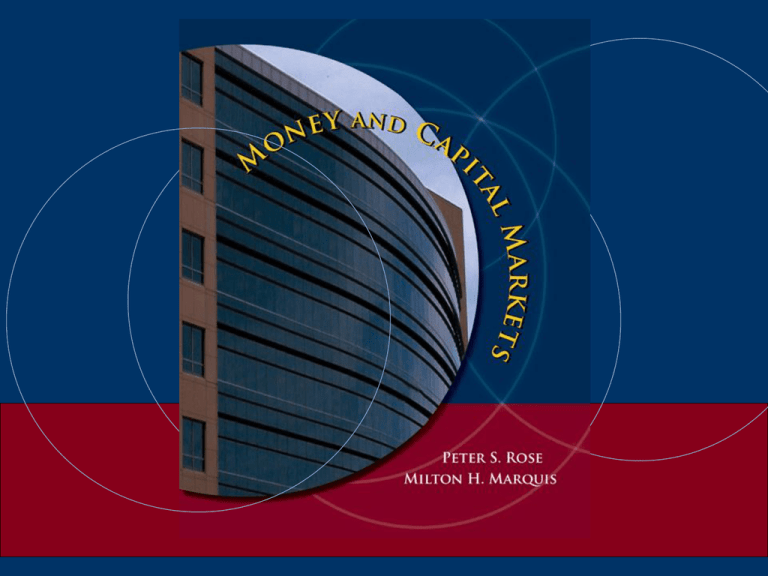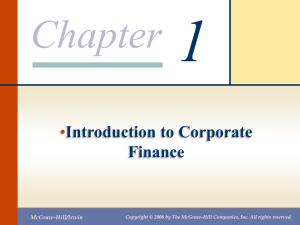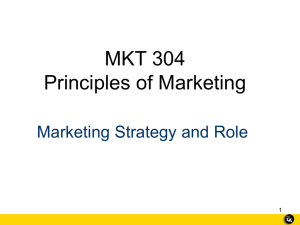
Chapter 5
The Determinants of
Interest Rates: Competing
Ideas
5-3
Learning Objectives
• To understand the important roles that interest rates play
within the economy.
• To explore the most important ideas about what determines the
level of interest rates and asset prices within the financial
system.
• To identify the key forces that economists believe set market
interest rates and asset prices into motion.
McGraw-Hill/Irwin
Money and Capital Markets, 9/e
© 2006 The McGraw-Hill Companies, Inc., All Rights Reserved.
5-4
Introduction
• The acts of saving and lending, and borrowing and investing,
are significantly influenced by and tied together by the interest
rate.
• The interest rate is the price a borrower must pay to secure
scarce loanable funds from a lender for an agreed-upon time
period.
McGraw-Hill/Irwin
Money and Capital Markets, 9/e
© 2006 The McGraw-Hill Companies, Inc., All Rights Reserved.
5-5
Introduction
• Some authorities refer to the rate of interest as the price of
credit.
• Interest rates send price signals to borrowers, lender, savers,
and investors.
• Whether higher interest rates increase or decrease savings and
investment depends on the relative strength of its effect on
supply and demand factors.
McGraw-Hill/Irwin
Money and Capital Markets, 9/e
© 2006 The McGraw-Hill Companies, Inc., All Rights Reserved.
5-6
Functions of the Interest Rate in the Economy
• The interest rate helps guarantee that current savings will flow
into investment to promote economic growth.
• It allocates the available supply of credit, generally providing
loanable funds to those investment projects with the highest
expected returns.
• It brings the supply of money into balance with the public’s
demand for money.
McGraw-Hill/Irwin
Money and Capital Markets, 9/e
© 2006 The McGraw-Hill Companies, Inc., All Rights Reserved.
5-7
Functions of the Interest Rate in the Economy
• The interest rate serves as an important tool for government
policy through its influence on the volume of savings and
investment.
McGraw-Hill/Irwin
Money and Capital Markets, 9/e
© 2006 The McGraw-Hill Companies, Inc., All Rights Reserved.
5-8
Functions of the Interest Rate in the Economy
• To help uncover these rate-determining forces, we assume that
there is one fundamental interest rate, known as the pure or
risk-free rate of interest, which is a component of all interest
rates.
• The closest real-world approximation to this pure rate of return
is the market interest rate on government bonds.
McGraw-Hill/Irwin
Money and Capital Markets, 9/e
© 2006 The McGraw-Hill Companies, Inc., All Rights Reserved.
5-9
The Classical Theory of Interest Rates
• The classical theory argues that the rate of interest is
determined by two forces:
the supply of savings, derived mainly from households, and
the demand for investment capital, coming mainly from the
business sector.
McGraw-Hill/Irwin
Money and Capital Markets, 9/e
© 2006 The McGraw-Hill Companies, Inc., All Rights Reserved.
5 - 10
The Classical Theory of Interest Rates
Household Savings
• Current household savings equal the difference between
current income and current consumption expenditures.
• Individuals prefer current over future consumption, and the
payment of interest is a reward for waiting.
• Higher interest rates encourage the substitution of current
saving for current consumption.
McGraw-Hill/Irwin
Money and Capital Markets, 9/e
© 2006 The McGraw-Hill Companies, Inc., All Rights Reserved.
5 - 11
The Classical Theory of Interest Rates
The Substitution Effect
Relating Savings and Interest Rates
Interest
Rate
r2
r1
S1
McGraw-Hill/Irwin
Money and Capital Markets, 9/e
S2
Current
Saving
© 2006 The McGraw-Hill Companies, Inc., All Rights Reserved.
5 - 12
The Classical Theory of Interest Rates
Business and Government Savings
• Most businesses hold savings balances in the form of retained
earnings, the amount of which is determined principally by
business profits, and to a lesser extent, by interest rates.
• Income flows in the economy and the pacing of government
spending programs are the dominant factors affecting
government savings (budget surplus).
McGraw-Hill/Irwin
Money and Capital Markets, 9/e
© 2006 The McGraw-Hill Companies, Inc., All Rights Reserved.
5 - 13
The Classical Theory of Interest Rates
The Demand for Investment Funds
• Gross business investment equals the sum of replacement
investment and net investment.
• One investment decision-making method involves the
calculation of a project’s expected internal rate of return, and
the comparison of that expected return with the anticipated
returns of alternative projects, as well as with market interest
rates.
McGraw-Hill/Irwin
Money and Capital Markets, 9/e
© 2006 The McGraw-Hill Companies, Inc., All Rights Reserved.
5 - 14
The Classical Theory of Interest Rates
The Demand for Investment Funds … continued
• The internal rate of return (r) equates the total cost of an
investment project with the future net cash flows (NCF)
expected from that project discounted back to their present
values.
• Cost of project =
NCFn
NCF1
NCF2
...
1
2
n
1 r 1 r
1 r
• Another method of investment analysis is the net present value
(NPV) approach.
McGraw-Hill/Irwin
Money and Capital Markets, 9/e
© 2006 The McGraw-Hill Companies, Inc., All Rights Reserved.
5 - 15
The Classical Theory of Interest Rates
The Cost of Capital and the Business Investment Decision
Expected
Internal
Rates of
Return on
Alternative
Investment
Projects
A – acceptable
15%
B – acceptable
12%
C – indifferent
10%
D
E
unprofitable 8%
unprofitable 7%
Cost of
Capital
Funds
= 10%
Dollar Cost of Investment Projects
McGraw-Hill/Irwin
Money and Capital Markets, 9/e
© 2006 The McGraw-Hill Companies, Inc., All Rights Reserved.
5 - 16
The Classical Theory of Interest Rates
The Investment Demand Schedule
In the Classical Theory of Interest Rates
Interest
Rate
r2
r1
I2
McGraw-Hill/Irwin
Money and Capital Markets, 9/e
I1
Investment
Spending
© 2006 The McGraw-Hill Companies, Inc., All Rights Reserved.
5 - 17
The Classical Theory of Interest Rates
The Equilibrium Rate of Interest In the Classical Theory
Interest
Rate Investment Savings
rE
QE
McGraw-Hill/Irwin
Money and Capital Markets, 9/e
Savings &
Investment
© 2006 The McGraw-Hill Companies, Inc., All Rights Reserved.
5 - 18
The Classical Theory of Interest Rates
Limitations
• Factors other than savings and investment that affect interest
rates are ignored. For example, many financial institutions can
“create” money today by making loans to the public.
• Today, economists recognize that income is more important
than interest rates in determining the volume of savings.
McGraw-Hill/Irwin
Money and Capital Markets, 9/e
© 2006 The McGraw-Hill Companies, Inc., All Rights Reserved.
5 - 19
The Classical Theory of Interest Rates
Limitations … continued
• In addition to the business sector, both consumers and
governments are also important borrowers today.
McGraw-Hill/Irwin
Money and Capital Markets, 9/e
© 2006 The McGraw-Hill Companies, Inc., All Rights Reserved.
5 - 20
The Liquidity Preference (Cash Balances)
Theory of Interest Rates
• The liquidity preference (or cash balances) theory of interest
rates is a short-term theory that was developed for explaining
near-term changes in interest rates, and hence, is more relevant
for policymakers.
• According to the theory, the rate of interest is the payment to
money (cash balances) holders for the use of their scarce
resource (liquidity), by those who demand liquidity (i.e.
money or cash balances).
McGraw-Hill/Irwin
Money and Capital Markets, 9/e
© 2006 The McGraw-Hill Companies, Inc., All Rights Reserved.
5 - 21
The Liquidity Preference (Cash Balances)
Theory of Interest Rates
• The demand for liquidity stems from:
the transactions motive - the purchase of goods and services
the precautionary motive - to cope with future emergencies and
extraordinary expenses
the speculative motive - a rise in interest rates results in lower
bond prices
and depend on the level of national income, business sales, and prices
(but not interest rates). So, demand due to and is fixed in the short
term.
McGraw-Hill/Irwin
Money and Capital Markets, 9/e
© 2006 The McGraw-Hill Companies, Inc., All Rights Reserved.
5 - 22
Speculative Demand for Money or Cash Balances
McGraw-Hill/Irwin
Money and Capital Markets, 9/e
© 2006 The McGraw-Hill Companies, Inc., All Rights Reserved.
5 - 23
The Total Demand for Money or Cash Balances
And the Equilibrium Rate of Interest
McGraw-Hill/Irwin
Money and Capital Markets, 9/e
© 2006 The McGraw-Hill Companies, Inc., All Rights Reserved.
5 - 24
The Liquidity Preference (Cash Balances)
Theory of Interest Rates
• In modern economies, the money supply is controlled, or at
least closely regulated, by the government.
• The supply of money (cash balances) is often assumed to be
inelastic with respect to interest rates, since government
decisions concerning the size of the money supply should
presumably be guided by public welfare.
McGraw-Hill/Irwin
Money and Capital Markets, 9/e
© 2006 The McGraw-Hill Companies, Inc., All Rights Reserved.
5 - 25
The Liquidity Preference (Cash Balances)
Theory of Interest Rates
The Equilibrium Interest Rate
In the Liquidity Preference Theory
Interest
Rate
Equilibrium
interest rate
Money
Supply
QE
McGraw-Hill/Irwin
Money and Capital Markets, 9/e
Total
Demand
Quantity of
Money / Cash
Balances
© 2006 The McGraw-Hill Companies, Inc., All Rights Reserved.
5 - 26
The Liquidity Preference (Cash Balances)
Theory of Interest Rates
Limitations
• The liquidity preference theory is a short-term approach. In the
longer term, the assumption that income remains stable does
not hold.
• Only the supply and demand for money is considered. A more
comprehensive view that considers the supply and demand for
credit by all actors in the financial system - businesses,
households, and governments - is needed.
McGraw-Hill/Irwin
Money and Capital Markets, 9/e
© 2006 The McGraw-Hill Companies, Inc., All Rights Reserved.
5 - 27
The Loanable Funds Theory of Interest
• The popular loanable funds theory argues that the risk-free
interest rate is determined by the interplay of two forces:
the demand for credit (loanable funds) by domestic businesses,
consumers, and governments, as well as foreign borrowers
the supply of loanable funds from domestic savings, dishoarding
of money balances, money creation by the banking system, as
well as foreign lending
McGraw-Hill/Irwin
Money and Capital Markets, 9/e
© 2006 The McGraw-Hill Companies, Inc., All Rights Reserved.
5 - 28
The Loanable Funds Theory of Interest
The Demand for Loanable Funds
• Consumer (household) demand is relatively inelastic with
respect to the rate of interest.
• Domestic business demand increases as the rate of interest
falls.
• Government demand does not depend significantly upon the
level of interest rates.
• Foreign demand is sensitive to the spread between domestic
and foreign interest rates.
McGraw-Hill/Irwin
Money and Capital Markets, 9/e
© 2006 The McGraw-Hill Companies, Inc., All Rights Reserved.
5 - 29
The Loanable Funds Theory of Interest
Total Demand for Loanable Funds (Credit)
Interest
Rate
Total Demand = Dconsumer +
Dbusiness +
Dgovernment +
Dforeign
Amount of
Loanable Funds
McGraw-Hill/Irwin
Money and Capital Markets, 9/e
© 2006 The McGraw-Hill Companies, Inc., All Rights Reserved.
5 - 30
The Loanable Funds Theory of Interest
The Supply of Loanable Funds
• Domestic Savings. The net effect of income, substitution, and
wealth effects is a relatively interest-inelastic supply of
savings curve.
• Dishoarding of Money Balances. When individuals and
businesses dispose of their excess cash holdings, the supply of
loanable funds available to others is increased.
McGraw-Hill/Irwin
Money and Capital Markets, 9/e
© 2006 The McGraw-Hill Companies, Inc., All Rights Reserved.
5 - 31
The Loanable Funds Theory of Interest
The Supply of Loanable Funds … continued
• Creation of Credit by the Domestic Banking System.
Commercial banks and nonbank thrift institutions offering
payments accounts can create credit by lending and investing
their excess reserves.
• Foreign lending is sensitive to the spread between domestic
and foreign interest rates.
McGraw-Hill/Irwin
Money and Capital Markets, 9/e
© 2006 The McGraw-Hill Companies, Inc., All Rights Reserved.
5 - 32
The Loanable Funds Theory of Interest
Total Supply of Loanable Funds (Credit)
Interest
Rate
Total Supply
= domestic savings +
newly created money +
foreign lending –
hoarding demand
Amount of
Loanable Funds
McGraw-Hill/Irwin
Money and Capital Markets, 9/e
© 2006 The McGraw-Hill Companies, Inc., All Rights Reserved.
5 - 33
The Loanable Funds Theory of Interest
The Equilibrium Interest Rate
Interest
Rate
rE
Supply
Demand
QE
McGraw-Hill/Irwin
Money and Capital Markets, 9/e
Amount of
Loanable Funds
© 2006 The McGraw-Hill Companies, Inc., All Rights Reserved.
5 - 34
The Loanable Funds Theory of Interest
• At equilibrium:
Planned savings = planned investment across the whole
economic system
Money supply = money demand
Supply of loanable funds = demand for loanable funds
Net foreign demand for loanable funds = net exports
McGraw-Hill/Irwin
Money and Capital Markets, 9/e
© 2006 The McGraw-Hill Companies, Inc., All Rights Reserved.
5 - 35
The Loanable Funds Theory of Interest
Interest rates will be stable only when the economy, money
market, loanable funds market, and foreign currency markets
are simultaneously in equilibrium.
McGraw-Hill/Irwin
Money and Capital Markets, 9/e
© 2006 The McGraw-Hill Companies, Inc., All Rights Reserved.
5 - 36
Changes in the Demand for and Supply of
Loanable Funds
McGraw-Hill/Irwin
Money and Capital Markets, 9/e
© 2006 The McGraw-Hill Companies, Inc., All Rights Reserved.
5 - 37
Changes in the Demand for and Supply of
Loanable Funds
McGraw-Hill/Irwin
Money and Capital Markets, 9/e
© 2006 The McGraw-Hill Companies, Inc., All Rights Reserved.
5 - 38
The Rational Expectations Theory of Interest
• The rational expectations theory builds on a growing body of
research evidence that the money and capital markets are
highly efficient in digesting new information that affects
interest rates and security prices.
McGraw-Hill/Irwin
Money and Capital Markets, 9/e
© 2006 The McGraw-Hill Companies, Inc., All Rights Reserved.
5 - 39
The Rational Expectations Theory of Interest
• The public forms rational and unbiased expectations about the
future demand and supply of credit, and hence interest rates.
Interest
Rate
rE
Expected Supply
Expected Demand
QE
McGraw-Hill/Irwin
Money and Capital Markets, 9/e
Amount of
Loanable Funds
© 2006 The McGraw-Hill Companies, Inc., All Rights Reserved.
5 - 40
The Rational Expectations Theory of Interest
• If the money and capital markets are highly efficient, then
interest rates will always be very near their equilibrium levels,
and the optimal forecast of next period’s interest rate is the
current interest rate.
• Interest rates will change only if entirely new and unexpected
information appears, and the direction of change depends on
the public’s current set of expectations.
McGraw-Hill/Irwin
Money and Capital Markets, 9/e
© 2006 The McGraw-Hill Companies, Inc., All Rights Reserved.
5 - 41
Expected Demand for and Supply of Loanable
Funds
McGraw-Hill/Irwin
Money and Capital Markets, 9/e
© 2006 The McGraw-Hill Companies, Inc., All Rights Reserved.
5 - 42
The Rational Expectations Theory of Interest
Limitations
• At the moment, we do not know very much about how the
public forms its expectations.
• The cost of gathering and analyzing information relevant to the
pricing of assets is not always negligible, as assumed.
• Not all interest rates and security prices appear to display the
kind of behavior implied by the rational expectations theory.
McGraw-Hill/Irwin
Money and Capital Markets, 9/e
© 2006 The McGraw-Hill Companies, Inc., All Rights Reserved.
5 - 43
Markets on the Net
•
•
•
•
•
•
Bank Rate.com at www.bankrate.com
Bond Market Association at www.investinginbonds.com
CNN/Money at www.cnnfn.com
European Central Bank at www.ecb.int/
Federal Reserve System at www.federalreserve.gov
National Endowment for Financial Education at www.nefe.org
McGraw-Hill/Irwin
Money and Capital Markets, 9/e
© 2006 The McGraw-Hill Companies, Inc., All Rights Reserved.
5 - 44
Chapter Review
• Introduction: Interest Rates and the Price of Credit
• Functions of the Interest Rate in the Economy
• The Classical Theory of Interest Rates
-
Savings by Households, Business Firms and Governments
The Demand for Investment Funds
The Equilibrium Interest Rate
Limitations of the Classical Theory
McGraw-Hill/Irwin
Money and Capital Markets, 9/e
© 2006 The McGraw-Hill Companies, Inc., All Rights Reserved.
5 - 45
Chapter Review
• The Liquidity Preference or Cash Balances Theory of Interest
Rates
-
The Demand for Liquidity
The Supply of Money (Cash Balances)
The Equilibrium Interest Rate
Limitations of the Liquidity Preference Theory
McGraw-Hill/Irwin
Money and Capital Markets, 9/e
© 2006 The McGraw-Hill Companies, Inc., All Rights Reserved.
5 - 46
Chapter Review
• The Loanable Funds Theory of Interest
- The Demand for Loanable Funds
- The Supply of Loanable Funds
- The Equilibrium Interest Rate
• The Rational Expectations Theory of Interest
McGraw-Hill/Irwin
Money and Capital Markets, 9/e
© 2006 The McGraw-Hill Companies, Inc., All Rights Reserved.





